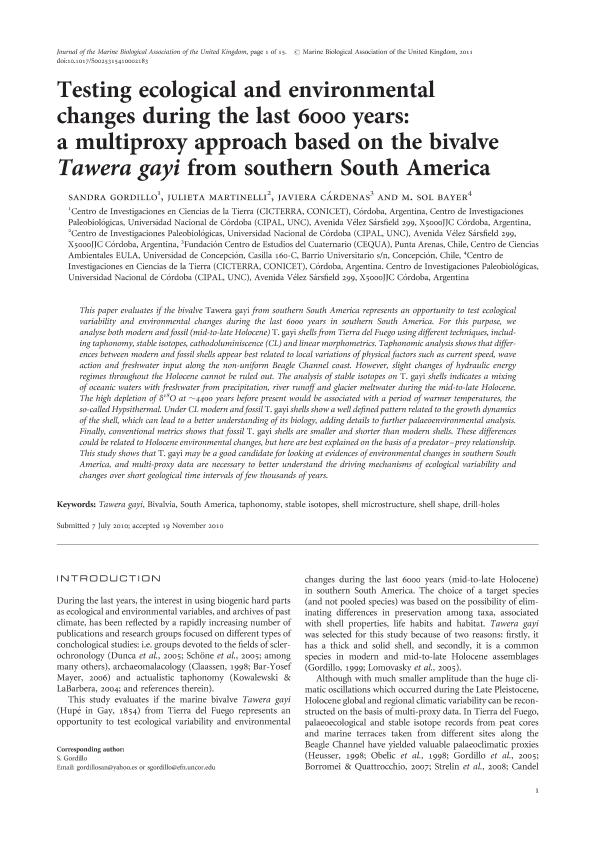Mostrar el registro sencillo del ítem
dc.contributor.author
Gordillo, Sandra

dc.contributor.author
Odisio Martinelli, Julieta

dc.contributor.author
Cardenas, Javiera

dc.contributor.author
Bayer, María Sol

dc.date.available
2024-03-06T18:21:23Z
dc.date.issued
2011-11
dc.identifier.citation
Gordillo, Sandra; Odisio Martinelli, Julieta; Cardenas, Javiera; Bayer, María Sol; Testing ecological and environmental changes during the last 6000 years: A multiproxy approach based on the bivalve Tawera gayi from southern South America; Cambridge University Press; Journal of the Marine Biological Association of the United Kingdom; 91; 7; 11-2011; 1413-1427
dc.identifier.issn
0025-3154
dc.identifier.uri
http://hdl.handle.net/11336/229566
dc.description.abstract
This paper evaluates if the bivalve Tawera gayi from southern South America represents an opportunity to test ecological variability and environmental changes during the last 6000 years in southern South America. For this purpose, we analyse both modern and fossil (mid-to-late Holocene) T. gayi shells from Tierra del Fuego using different techniques, including taphonomy, stable isotopes, cathodoluminiscence (CL) and linear morphometrics. Taphonomic analysis shows that differences between modern and fossil shells appear best related to local variations of physical factors such as current speed, wave action and freshwater input along the non-uniform Beagle Channel coast. However, slight changes of hydraulic energy regimes throughout the Holocene cannot be ruled out. The analysis of stable isotopes on T. gayi shells indicates a mixing of oceanic waters with freshwater from precipitation, river runoff and glacier meltwater during the mid-to-late Holocene. The high depletion of δ18O at ~4400 years before present would be associated with a period of warmer temperatures, the so-called Hypsithermal. Under CL modern and fossil T. gayi shells show a well defined pattern related to the growth dynamics of the shell, which can lead to a better understanding of its biology, adding details to further palaeoenvironmental analysis. Finally, conventional metrics shows that fossil T. gayi shells are smaller and shorter than modern shells. These differences could be related to Holocene environmental changes, but here are best explained on the basis of a predator–prey relationship. This study shows that T. gayi may be a good candidate for looking at evidences of environmental changes in southern South America, and multi-proxy data are necessary to better understand the driving mechanisms of ecological variability and changes over short geological time intervals of few thousands of years.
dc.format
application/pdf
dc.language.iso
eng
dc.publisher
Cambridge University Press

dc.rights
info:eu-repo/semantics/openAccess
dc.rights.uri
https://creativecommons.org/licenses/by-nc-sa/2.5/ar/
dc.subject
TAWERA GAYI
dc.subject
BIVALVIA
dc.subject
SOUTH AMERICA
dc.subject
TAPHONOMY
dc.subject.classification
Paleontología

dc.subject.classification
Ciencias de la Tierra y relacionadas con el Medio Ambiente

dc.subject.classification
CIENCIAS NATURALES Y EXACTAS

dc.title
Testing ecological and environmental changes during the last 6000 years: A multiproxy approach based on the bivalve Tawera gayi from southern South America
dc.type
info:eu-repo/semantics/article
dc.type
info:ar-repo/semantics/artículo
dc.type
info:eu-repo/semantics/publishedVersion
dc.date.updated
2024-03-05T13:20:17Z
dc.journal.volume
91
dc.journal.number
7
dc.journal.pagination
1413-1427
dc.journal.pais
Reino Unido

dc.journal.ciudad
Cambridge
dc.description.fil
Fil: Gordillo, Sandra. Consejo Nacional de Investigaciones Científicas y Técnicas. Centro Científico Tecnológico Conicet - Córdoba. Centro de Investigaciones en Ciencias de la Tierra. Universidad Nacional de Córdoba. Facultad de Ciencias Exactas Físicas y Naturales. Centro de Investigaciones en Ciencias de la Tierra; Argentina. Universidad Nacional de Córdoba. Facultad de Ciencias Exactas Físicas y Naturales. Centro de Investigaciones Paleobiológicas; Argentina
dc.description.fil
Fil: Odisio Martinelli, Julieta. Universidad Nacional de Córdoba. Facultad de Ciencias Exactas Físicas y Naturales. Centro de Investigaciones Paleobiológicas; Argentina
dc.description.fil
Fil: Cardenas, Javiera. Universidad de Concepción; Chile. Macquarie University; Australia
dc.description.fil
Fil: Bayer, María Sol. Universidad Nacional de Córdoba. Facultad de Ciencias Exactas Físicas y Naturales. Centro de Investigaciones Paleobiológicas; Argentina. Consejo Nacional de Investigaciones Científicas y Técnicas. Centro Científico Tecnológico Conicet - Córdoba. Centro de Investigaciones en Ciencias de la Tierra. Universidad Nacional de Córdoba. Facultad de Ciencias Exactas Físicas y Naturales. Centro de Investigaciones en Ciencias de la Tierra; Argentina
dc.journal.title
Journal of the Marine Biological Association of the United Kingdom

dc.relation.alternativeid
info:eu-repo/semantics/altIdentifier/url/https://www.cambridge.org/core/journals/journal-of-the-marine-biological-association-of-the-united-kingdom/article/abs/testing-ecological-and-environmental-changes-during-the-last-6000-years-a-multiproxy-approach-based-on-the-bivalve-tawera-gayi-from-southern-south-america/5C047171725DC122AE2F4A0A710BB98D
dc.relation.alternativeid
info:eu-repo/semantics/altIdentifier/doi/https://doi.org/10.1017/S0025315410002183
Archivos asociados
